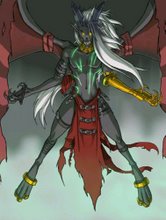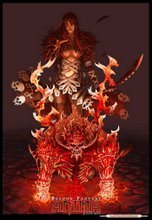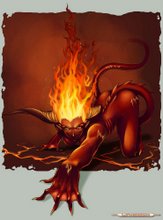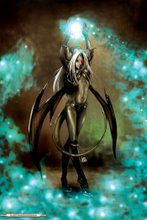
 Parkour
ParkourThe Parkour (or art of the displacement) is a discipline that consists of moving by urban or natural means, surpassing the obstacles which they appear in your route (fences, walls, emptiness...) of possible the most fluid and efficient form, and with the only possibilities of the human body. This discipline requires a great physical training to make the different movements (jumps, pasavallas, scaling, etc.) that it implies, but in addition it is necessary a decided mind to surpass the own fears, a great concentration, and a strong spirit.
The experienced medical instructors more agree in which the Parkour is a philosophy. Clear it is that there is no a specific and rigid philosophy for the art in particular, but that stops each one means a different thing. For it can simply be a sport with which they are entertained, but they live it, and for other his life it turns around him, others can feel it like an art with which they are expressed, and for others it is a autosuperación philosophy, or to walk ways different from the one from the rest of people, etc. What yes we must consider it is that good traceur never bothers to people or the surroundings, never puts in danger his own life if he is not sure that certain jump is going it to obtain, and never competes against other people. The objective of parkour is the free and fluid movement. A rule in parkour is not to back down. Its motto is: "To be and To last". This means that traceur does not have to put in danger and is surpassed every day, and does not have to compete nor to try to surpass to the others. Parkour is to make a route of possible the easy and effective way but.
Acrobatics
Called movements exist "tricks" (incorrectly called tricks, because trick would include a kick, to gainer, etc.) that normally they consist of rotations of body of the air like mortals, frontflips, backflips, wallflips, aerials, Arabs, etc... But these movements do not comprise of the Parkour since not only usually they reduce speed, but that is not faithful to the motto of the sport by the risk and the inefficiency that entails. Tricks more usually is used by the people dedicated to XMA (Artes Marciales Extremas) but many traceurs use to add them plasticity and to make an impression in their routes. Nevertheless, to others traceurs they do not like these movements and they omit them at any moment. At this moment in the community of traceurs worldwide there is a great controversy on tricks.
Equipment of ``Traceur´´
The particularitity of this sport is in its simplicity, so single is necessary a comfortable footwear, that it takes hold well with the ground and a good damping. This is specially important dice the great number of hits that all the inferior train takes during the reception of the jumps. As far as the clothes nothing specific is required, simply has to be comfortable clothes that allow the great mobility us to make without ties each movement.
Movements
 The own movements of parkour characterize by their effectiveness and fluidity. It does not serve as anything to jump a fence with the purpose of raising to the legs the maximum that you can, must be with the purpose of passing it fastest possible. It is necessary to have certain originality with the movements, since cat-precision are many possible linkings, cat-arm, cat-pasavallas, double cat, pasamurallas-to review, lateral reverse-arm, rotations, etc.
The own movements of parkour characterize by their effectiveness and fluidity. It does not serve as anything to jump a fence with the purpose of raising to the legs the maximum that you can, must be with the purpose of passing it fastest possible. It is necessary to have certain originality with the movements, since cat-precision are many possible linkings, cat-arm, cat-pasavallas, double cat, pasamurallas-to review, lateral reverse-arm, rotations, etc.Receptions
 Basic reception: The contact with the ground has to be made in order distribute the weight of the impact by all the body. The heels do not have to be called on the ground, better to maintain them slightly high so that they serve as damping. The knees also must be semiflexionadas. The inclined back forwards, with the hands ahead to have prepared them in case it is necessary to use them.
Basic reception: The contact with the ground has to be made in order distribute the weight of the impact by all the body. The heels do not have to be called on the ground, better to maintain them slightly high so that they serve as damping. The knees also must be semiflexionadas. The inclined back forwards, with the hands ahead to have prepared them in case it is necessary to use them.Rotation: This technique will serve as reception to a jump in speed, is a voltereta supported in a shoulder (rolling oblique on the back), that will allow us to evade part of the impact of the fall, after a reception with much inertia towards ahead.
Reception of a precision jump: It will be made with the front part of the plant of the foot (between the ball of the foot and the fingers), semiflexionando the knees and the back so that we distribute the impact of the jump more equitably possible by the body, and also to hold the balance.
Reception of arm jump: It will be made with the front part of the plant of the feet and the hands in the superior part of the obstacle. If it is a fence, the knees will be flexionarán to cushion the impact. In a wall, normally they are let slip the legs until being hung of the wall only with the hands.
Reception in branch: It will be recepcionará solely in a branch with the hands, but letting to us balance to avoid a dry blow in the arms and the back. It is necessary to have well-taken care of of not falling backwards when we are in the front part of the oscillation (the first oscillation).
Pasavallas: Fundamental movement in which we will try to exceed the obstacle of possible the fastest and fluid form supporting a single hand in him; this movement will serve to us as it connects of the race when we are a fence or similar element in our route.
Jump of cat: It is a jump in that we will cross an obstacle supporting to us in him with the hands in parallel during the jump, later to pass the together and flexionadas legs between the hands. It is a movement very used that you will recognize easily. If the hands are left in the obstacle after passing the legs ahead, then call is a chained movement 'gato-rompemuñecas'.
Passage of the cat: Similar to the jump of the single cat which a longer surface is made in one more, where we must stretch to us in the air to arrive at the end of the obstacle, where we will put the hands later to pass the legs between the hollow that these leave.
Double cat: Similar to the passage of the single cat that when arriving at the object first leans the hands of him in the beginning, and when one is by the end of this we become to impel with the hands, soon to pass the legs between the hollow that these leave.
Reverso: This movement tries to cross a fence, railing or wall, being supported to us in her with the hands, and making a turn of 360º positioning the body in horizontal, of backs to the front with the raised legs to prepare a good reception.
Thief: Running oblique towards the obstacle, we do pasavallas where first we put a hand, later we passed the legs stretched, and later the other hand.
Lateral Pasavallas: He is similar to pasavallas and to the thief but in this it is run parallelly and the first hand is put since to do ladron but it skips with the leg that this next to the fence stretching the other upwards at the same time and shrinking the leg with which we have jumped not to enlist it with the fence and finally recepcionando with the prim foot and the other free hand in the fence.
Rompemuñecas: He is like a 'gato frontal', in that the legs go first, prim, and later the hands are put.
Underbar or Franchissement in French: A fence or a hollow under diverse ways goes; generally, we helped ourselves of the hands in the superior part of the hollow to pass the body.
Jumps
 Jump of precision: This it is a jump of 'longitud' without run, in which the aim will be a precise reception in a fence, wall or narrow curb.
Jump of precision: This it is a jump of 'longitud' without run, in which the aim will be a precise reception in a fence, wall or narrow curb. Jump of precision: This it is a jump of 'longitud' without run, in which the aim will be a precise reception in a fence, wall or narrow curb.
Long jump: It is a long jump in race.
Jump of bottom: This it is a jump downwards and depending on the inertia towards ahead that takes, he will be advisable a rotation.
Others
 Pass-walls: One is to exceed a high wall; run will be needed to arrive at the top the wall, beating a kick on this raising to us, and above we will take hold ourselves with the hands (one and later another one if he is too high) to raise pulse.
Pass-walls: One is to exceed a high wall; run will be needed to arrive at the top the wall, beating a kick on this raising to us, and above we will take hold ourselves with the hands (one and later another one if he is too high) to raise pulse. Grimpeo: Grimpear in parkour, is a fast scaling, well of a wall with a pronounced inclination, a tree, etc.
Plate (of it irons in French): It consists of arriving at a position where we hold on the hands (to the height of the waist) in a horizontal bar, from a position where we are hung of the hands, stretched totally. It is a force exercise that helps in the pass-walls.
180: One is to give average returned in the air, against an obstacle (wall or fence), to end the hands in him, across, and in a position of which we pruned to off-hook to us.
Released: After 180, to drop itself. It is possible to be returned to give average return in the air to continue running in the same direction.
Tic-Tac: This movement, consists to jump on a fence or wall not very high helping us of some element, or wall that it has in a lateral one, supporting in this a foot to kick that it impels to us.
Balance: In a branch or it sweeps, we will try to hang itself with the hands in, to let to us oscillate. In order to leave towards ahead it is necessary to have well-taken care of of not falling backwards. It is necessary to maintain a balance in that we are able to hold the position in the air, to recepcionar correctly.
Laché (French name): Hung of a high branch, we loosen the hands to recepcionar in another one more loss, maintaining a position in the air that us of balance and damping.
Balance: To make balance in a fence, unemployed or walking in her, to do the pine maintaining the balance...
Quadruped movement: To walk to 'cuatro patas'. If one becomes level with ground or in stairs, it serves like a good physical exercise. In a fine wall or a fence, in addition the balance works (in that case 'equilibrio of gato' is called;).
360º: One is to do a turn of 360º on a support helping us only the hands.
360º reverso: Just like the previous one, only that instead of doing it of face, we will make it of backs to the support. Jump of lion: A jump in which we sent ourselves on the head obstacle, without touching it, to fall superficially in the other side happening and making a rotation in the ground.
Notes and References
Not more of 90º, if we would not be damaging the meniscos of the knees.
At the moment is controversy on the utility, effectiveness and use of 360º's. uses it only of decoration, others to pass obstacles, which considers moral ethically. Others reject it because they do not see utility him.
http://parkour.net/modules/wiki/index.php?page=basics&lang=es
Enlaces externos
UMparkour.com Primera web española de parkour.
http://www.youtube.com/watch?v=3l2GWC0AFrwYamakasi











No hay comentarios:
Publicar un comentario